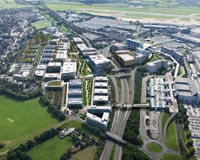 When the government announced its £15bn road building programme you couldn’t hear the traffic for the cheering.
When the government announced its £15bn road building programme you couldn’t hear the traffic for the cheering.
The list of 127 schemes included eye-catching plans for a tunnel under Stonehenge, long-awaited improvements to capacity on the M25 and an on-off plan to improve the A14 near Huntingdon. The government promised 1,300 miles of motorway and A-road widening.
It was such great news, according to the Freight Transport Association, that its press statement cut-and-pasted a quote from transport secretary Patrick McLoughlin saying how great it was. McLoughlin called it the “biggest, boldest and most far-reaching roads programme for decades”.
Others weren’t so sure. Sceptics immediately pointed out that this was a re-announcement of a plan dating from 2013, including much from 2010; contained many schemes already under construction; and omitted nine earlier projects along with about £500m of inflation-adjusted funding.
With the cheers now a distant memory, and with four months to reflect, the real impact for the distribution sector is becoming clear. A consensus is growing that the £15bn infrastructure investment will be useful in a handful of locations, not very useful in others, and isn’t, in fact, a game-changer. Indeed, some big opportunities to make a difference to national infrastructure have been missed. Where, for instance, is the conversion of the A14 into a motorway?
The main winners will be Liverpool, south Manchester, Thurrock, Tilbury and Gatwick. Lambert Smith Hampton estimates that the seven big projects could improve the prospects of around 1,000 acres, opening the door to around 27m sq ft of development land for industrial and logistics use.
The seven road infrastructure projects that LSH think will have the greatest impact on the industrial and logistics market
Steve Williams, head of LSH’s national industrial and logistics team, argues that only a handful of projects have the potential to make a difference.
He says: “The announcement was billed as “the most far-reaching roads programme for decades”, but it doesn’t seem particularly revolutionary from the perspective of the logistics industry. It was a rehash of earlier announcements and headline-grabbers rather than a real help to logistics.”
Williams believes a handful of projects have the potential to make a difference in specific regions, with investment in the M6, A34 and A1 being well overdue. “Improvements to junction 30 of the M25 should support the continued expansion of the logistics sector around Thurrock, the Port of Tilbury and London Gateway,” he says.“This area has become a major logistics hub over the past few years, and it is vital that the surrounding road network continues to grow in step with development activity.”
A sensible idea, says Williams, is introducing four lanes running to the M25 between junctions 10 and 16. “We will watch with interest the results of the studies to improve links across the Pennines,” he says.
“But we would like to see action taken to widen the entirety of the A14, effectively converting it into a motorway. That would be a game-changer because it connects the east coast ports to the Midlands. What we’ve got in the plan is some tinkering with the A14 at Huntingdon,” adds Williams.
 Mike Hatfield, senior consultant at transport and logistics advisors MDS Transmodal, agrees. “Obviously some of these schemes will benefit logistics,” he says. “I’d flag the 5km stretch linking the M57/58 to the Port of Liverpool (pictured right). It will replace a stretch of traffic-light strewn urban dualling with an uninterrupted route. Combine the new road with the port’s new deep-water container terminal and Peel’s plans for port-centric logistics, and you have something big.
Mike Hatfield, senior consultant at transport and logistics advisors MDS Transmodal, agrees. “Obviously some of these schemes will benefit logistics,” he says. “I’d flag the 5km stretch linking the M57/58 to the Port of Liverpool (pictured right). It will replace a stretch of traffic-light strewn urban dualling with an uninterrupted route. Combine the new road with the port’s new deep-water container terminal and Peel’s plans for port-centric logistics, and you have something big.
“Liverpool is a lot more attractive after the road improvements, but overall the £15bn programme will not open up land which is currently out of bounds for logistics,” he says.
The Liverpool scheme, costed at between £250-£500m sees improvements to the A5036 Princess Way.
Like many, Hatfield would have liked to see the government announce more improvement to the A14. Today the A14 is being widened to three lanes between junctions 7 and 9 at Kettering (£25-£50m) and Cambridge to Huntington (£500m-plus), along with a new junction 10a at Kettering, which is still subject to funding talks.
Hatfield says: “They’ve taken steps to clear one of the bottlenecks on the A14 where it converges with the M11 and A1, and the road just wasn’t designed for today’s traffic. One traffic incident can block freight from Felixstowe and the Thames ports to the Midlands.”
Ghislaine Halpenny, assistant director for planning and regeneration at the British Property Federation, shares the sense that more might have been achieved if less had been attempted.
She says: “A shorter list of bigger schemes would have been more significant. For instance, our research often comes back down to the state of the A14. We’ve done some work with the Local Government Association and Kettering council on regeneration. The town has a clear vision for growth but it hinges on a new junction on the A14.”
Thinking more generally of the impact on the logistics sector – and logistics property – Halpenny says: “Perhaps the government is pulling at the wrong end of the system, and the blockage isn’t with roads but lies party in attitudes to logistics – which are out of date – and on the way land is allocated. Today we’re seeing feverish calls for more residential land at the expense of other users, including industrial and logistics.”
Three cheers for the government’s £15bn road building programme? It seems that as far as logistics property is concerned, it might score two.
Other routes
An announcement quietly released just before Christmas could be as significant for logistics property as the much-fanfared £15bn roads programme.
The new national policy statement for road and rail networks could act as a boost for the industrial sector.
The statement sets out how decisions on nationally significant road schemes will be taken and is expected to be a significant help to new applications.
Although the strategic road network makes up only 2% of the roads in England, it carries two-thirds of all freight traffic, much of which is transported to and from industrial parks.
The British Property Federation, which recently set up an industrial committee to make government aware of the challenges facing the industrial sector, welcomed the new document.
 A road to riches?
A road to riches?
The new A6 to Manchester Airport relief road could turn out to be among the most significant of the new road schemes. But it isn’t identified in the £15bn roads programme.
It is intended to boost Manchester’s enterprise zone at Airport City (pictured right), as well as help a large swathe of the city’s suburban south. Additional economic output of up to £2.5bn is anticipated.
The 10km dualling between the A6 and the airport is a priority project in the first GM City Deal with government. Main contract works begin this month and will be complete by autumn 2017.
Stockport council chief executive Eamonn Boylan says: “The road will deliver sustainable long-term access to Airport City, one of the largest growth sites in the UK. We’re not looking to specifically unlock development sites, although some will obviously be more deliverable as a result.”
The impact will be multiplied thanks to work on southern access to Manchester at Knutsford, as announced in 2010 but re-announced in the 2015 programme. This envisages replacing the A556 between the M56 and the M6 with grade-separated dual carriageway, including a bypass around Mere, improving a road that serves as the main southern access to the city.
LSH’s Steve Williams says: “Roads like these could bring significant connections east-west, and will make sites more attractive.”










